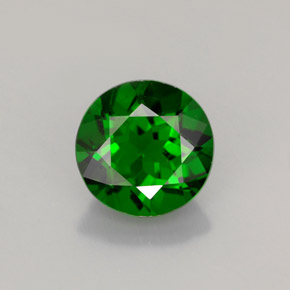The Gemstone Diopside

Diopside has been regarded only as a collector's gemstone until recently, when the deep forest-green Chrome Diopside variety has made its way into the mainstream gemstone market. Although its intense green color rivals that of Emerald, its low hardness makes it prone to scratches, thus limiting it from overwhelming the gemstone industry.
Color
?
Green, Yellow, Brown, Black
Chemical Formula
?
CaMgSi
2O
6
All About
Although Diopside occurs in a variety of colors, the green color is the
most common form. A purple type known as
Violane is occasionally
used as a gemstone, and
Star Diopside is very dark green to black. But the form of this stone that puts this gemstone on the map is the deep green
Chrome Diopside form.
Chrome Diopside in limited quantity is known from several localities, but a large commercially exploitable deposit discovered in Siberia in 1988 made this gemstone readily available to the market. Since then, Pakistan has also become a signficant producer of Chrome Diopside. Chrome Diopside is an affordable gemstone that has an intense forest-green color which rivals that of more expensive
Tsavorite and Green
Chrome Tourmaline.
Deep green color combined with transparency give a stone more value. Except in lighter colored stones, the faceting of larger cuts is generally avoided because the deep green color tends to make its tone too black. Careful cutting is also necessary in larger stones to keep the facet angles shallow to improve brilliance. The deep green color of Chrome
Diopside is natural and not enhanced.
Uses
?
Chrome Diopside is faceted into gemstone cuts mainly for earrings and pendants. It is generally not used for rings and bracelet due to its low hardness.
Star Diopside and the purple variety
Violane are faceted into
cabochons mostly as collectors gems.
Treatments & Enhancements
?
Diopside gemstones are natural and not heated or enhanced.
Diopside Sources
?
Diopside of facetable nature comes from Italy, Austria, Finland, Tanzania, Madagascar, Mynamar (Burma), China, and the U.S. (New York). The source of most gem
is from Russia, but other deposits also exist in Pakistan, Afghanistan, and Finland.
Violane is primarily from Italy, and
Star Diopside from India.
Similar Gemstones
?
Chrome Diopside has a similar color to both
Tsavorite and
Chrome Tourmaline, but is softer than those gemstones. The color is also a more forest-green hue than
Emerald.
Diopside in the Rough Photos
?